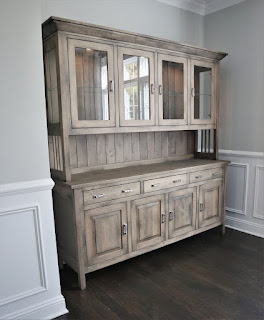DIY Hutch Furniture Plans for Classic and Modern Homes
The hutch, a versatile and adaptable piece of furniture, has graced homes for centuries. From its humble beginnings as a simple storage unit to its modern iterations as a stylish focal point, the hutch continues to offer both practicality and aesthetic appeal. This article delves into the construction of DIY hutches, providing detailed plans suitable for both classic and modern home styles. We will explore various design considerations, material choices, and construction techniques to empower you to create a unique and personalized hutch for your space.
Planning Your DIY Hutch Project
Before embarking on your DIY hutch journey, meticulous planning is crucial. This phase will determine the success and satisfaction of your project. Consider the following aspects:
Defining Your Style and Functionality
The first step is to clearly define the style and intended functionality of your hutch. Are you aiming for a rustic, classic, or modern aesthetic? Will it primarily serve as display space, storage, or a combination of both? A classic hutch might incorporate ornate detailing, while a modern hutch could feature clean lines and minimalist design. Consider the existing décor of your home and select a style that complements it seamlessly. Functionality should also be a key driver. Decide on the number of shelves, drawers, and doors required to meet your storage needs. Sketching preliminary designs can help visualize the final product and refine your vision.
Choosing the Right Materials
Material selection significantly impacts the overall look, durability, and cost of your hutch. Popular choices include:
- Wood: Offers a timeless appeal and is available in a wide variety of species, each with unique characteristics and price points. Hardwoods like oak, maple, and cherry are durable and aesthetically pleasing but more expensive. Softwoods such as pine and fir are more affordable but may require more careful handling.
- Plywood: A cost-effective alternative to solid wood, plywood offers excellent stability and is suitable for both interior and exterior applications. Choose a high-quality plywood with a smooth finish for optimal results.
- MDF (Medium-Density Fiberboard): A relatively inexpensive material that can be easily painted or stained. However, it is less durable than wood and more susceptible to damage. MDF is best suited for less demanding applications.
- Metal: For a modern industrial look, consider metal framing or accents. Metal offers durability and clean lines, but requires specific tools and expertise for construction.
Determining Dimensions and Measurements
Precise measurements are paramount to ensure the hutch fits your designated space and meets your storage requirements. Carefully measure the available space, considering factors such as ceiling height, wall outlets, and surrounding furniture. Create detailed drawings with accurate dimensions for all components, including shelves, doors, drawers, and the overall structure. This detailed plan will serve as your blueprint throughout the construction process. Don't forget to account for the thickness of materials when calculating overall dimensions.
Constructing Your DIY Hutch: Classic Style
A classic hutch often evokes a sense of warmth and tradition. Construction typically involves traditional joinery techniques and a focus on ornate details.
Classic Hutch Design Elements
Classic hutches often feature:
- Raised panel doors: These doors add a touch of elegance and sophistication.
- Ornate molding and trim: Detailed molding enhances the overall aesthetic appeal.
- Turned legs or feet: These add a touch of classic charm.
- Glass-paned doors: Allow for the display of cherished items.
- Multiple shelves: Provide ample storage space.
Construction Techniques for Classic Hutches
Traditional joinery techniques, such as mortise and tenon joints, dovetail joints, and dowel joints, are often employed in classic hutch construction. These techniques create strong, durable joints that enhance the longevity and stability of the piece. The use of wood glue and clamps is essential to ensure a secure bond between components. Sanding and finishing are crucial steps to achieve a smooth, polished surface and to protect the wood from damage.
Constructing Your DIY Hutch: Modern Style
Modern hutches prioritize clean lines, minimalist designs, and functionality. Construction often involves simpler joinery techniques and a focus on sleek aesthetics.
Modern Hutch Design Elements
Modern hutches often feature:
- Simple, straight lines: Eliminating ornate detailing contributes to a clean look.
- Sleek metal hardware: Adds a touch of industrial chic.
- Open shelving: Creates a sense of spaciousness and allows for the display of items.
- Integrated lighting: Highlights displayed items and enhances the overall aesthetic.
- Minimalist color palette: Neutrals or bold monochromatic colors contribute to a contemporary vibe.
Construction Techniques for Modern Hutches
Modern hutch construction often utilizes simpler joinery methods, such as pocket hole joinery, butt joints reinforced with screws, or dado joints. These techniques are quicker and easier to execute than traditional joinery. The use of plywood or MDF can streamline the construction process. A focus on precision cutting and clean lines is paramount to achieve the desired minimalist aesthetic. A simple finish, such as a clear coat or a single coat of paint, completes the project.
Finishing Touches and Safety Considerations
Regardless of the chosen style, several finishing touches and safety considerations are critical:
Finishing Your Hutch
Proper finishing enhances both the appearance and durability of your hutch. This may involve sanding to achieve a smooth surface, applying a stain or paint, and applying a protective sealant or varnish. Consider using high-quality finishes that are appropriate for the chosen material. Ensure adequate ventilation during the finishing process to avoid inhaling harmful fumes.
Safety Precautions
Always prioritize safety during the construction process. Wear appropriate safety gear, including safety glasses, dust masks, and hearing protection. Use caution when operating power tools and follow the manufacturer's instructions carefully. Ensure the hutch is stable and secure once assembled to prevent tipping or accidental injury.
Creating a DIY hutch is a rewarding project that allows for personalization and creativity. By carefully planning the design, selecting appropriate materials, and following safe construction practices, you can build a beautiful and functional piece of furniture that will enhance your home for years to come.



No comments:
Post a Comment